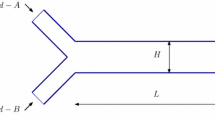Abstract
The hydrodynamics of flow through two-dimensional parallel-plate microchannels with periodic hydrophobic strips under finite Reynolds numbers is studied using dissipative particle dynamics simulations. The hydrophobic and hydrophilic regions are modeled using partial-slip and no-slip boundary conditions, respectively. We first consider channels with symmetric hydrophobic strips on both walls. It was observed that the volume flow rate through the channel is nonlinearly dependent on the area fraction of the hydrophobic strips. Next, we study flow in an antisymmetric channel in which the hydrophobic strips on the two channel walls are staggered with an axial offset. We observe that, in contrast to the symmetric channels, the presence of antisymmetric strips cause a finite velocity component towards the center of the channel. This cross-stream velocity field may potentially prove useful for separating second-phase particles or enhancing mixing in such microchannels.
















Similar content being viewed by others
References
Asmolov E, Zhou J, Schmid F, Vinogradova O (2013) Effective slip-length tensor for a flow over weakly slipping stripes. Phys Rev E 88(023):004
Bazant MZ, Vinogradova OI (2008) Tensorial hydrodynamic slip. J Fluid Mech 613:125–134
Belyaev A, Vinogradova O (2010) Effective slip in pressure-driven flow past super-hydrophobic stripes. J Fluid Mech 652:489–499
Benzi R, Biferale L, Sbragaglia M, Succi S, Toschi F (2006) Mesoscopic modelling of heterogeneous boundary conditions for microchannel flows. J Fluid Mech 548:257–280
Bocquet L, Barrat JL (1994) Hydrodynamic boundary conditions, correlation functions, and kubo relations for confined fluids. Phys Rev E 49(4):3079
Chakraborty S, Anand KD (2008) Implications of hydrophobic interactions and consequent apparent slip phenomenon on the entrance region transport of liquids through microchannels. Phys Fluids 20(4):043,602
Cheng Y, Teo C, Khoo B (2009) Microchannel flows with superhydrophobic surfaces: effects of reynolds number and pattern width to channel height ratio. Phys Fluids 21(12):1–12
Choi CH, Kim CJ (2006) Large slip of aqueous liquid flow over a nanoengineered superhydrophobic surface. Phys Rev Lett 96(066):001
Choi CH, Ulmanella U, Kim J, Ho CM, Kim CJ (2006) Effective slip and friction reduction in nanograted superhydrophobic microchannels. Phys Fluids 18(8):087,105
Davies J, Maynes D, Webb B, Woolford B (2006) Laminar flow in a microchannel with superhydrophobic walls exhibiting transverse ribs. Phys Fluids 18(8):087110
Fan X, Phan-Thien N, Yong NT, Wu X, Xu D (2003) Microchannel flow of a macromolecular suspension. Phys Fluids 15(1):11–21
Groot R, Warren P (1997) Dissipative particle dynamics: bridging the gap between atomistic and mesoscopic simulation. J Chem Phys 107(11):4423–4435
Harting J, Kunert C, Hyvluoma J (2010) Lattice boltzmann simulations in microfluidics probing the no-slip boundary condition in hydrophobic, rough, and surface nanobubble laden microchannels. Microfluid Nanofluid 8(1):1–10
Hoogerbrugge PJ, Koelman JMVA (1992) Simulating microscopic hydrodynamic phenomena with dissipative particle dynamics. Europhys Lett 19(3):155–160
John Philip R (1972a) Flows satisfying mixed no-slip and no-shear conditions. Zeitschrift fr angewandte Mathematik und Physik ZAMP 23:353–372
John Philip R (1972b) Integral properties of flows satisfying mixed no-slip and no-shear conditions. Zeitschrift fr angewandte Mathematik und Physik ZAMP 23:960–968
Lauga E, Stone H (2003) Effective slip in pressure-driven stokes flow. J Fluid Mech 489:55–77
Lauga E, Brenner MP, Stone HA (2007) Microfluidics: the no-slip boundary condition. Handbook of Experimental Fluid Dynamics pp 1219–1240
Lee C, Choi CH, Kim CJ (2008) Structured surfaces for a giant liquid slip. Phys Rev Lett 101(6):064,501
Moeendarbary E, Ng T, Zangeneh M (2009) Dissipative particle dynamics: introduction, methodology and complex fluid applications—a review. Int J App Mech 1(4):737–763
Navier CLMH (1823) Memoire sur les lois du mouvement des fluides. Mem Acad R Sci Inst France 6:389–440
Ou J, Perot B, Rothstein J (2004) Laminar drag reduction in microchannels using ultrahydrophobic surfaces. Phys Fluids 16(12):4635–4643
Ou J, Moss G, Rothstein J (2007) Enhanced mixing in laminar flows using ultrahydrophobic surfaces. Phys Rev E 76(1):016,304
Pan W, Pivkin IV, Karniadakis GE (2008) Single-particle hydrodynamics in DPD: a new formulation. Europhys Lett 84(1):10,012
Pivkin IV, Karniadakis GE (2006) Controlling density fluctuations in wall-bounded dissipative particle dynamics systems. Phys Rev Lett 96(206):001
Ranjith SK, Patnaik BSV, Vedantam S (2013a) Hydrodynamics of the developing region in hydrophobic microchannels: a dissipative particle dynamics study. Phys Rev E 87(033):303
Ranjith SK, Patnaik BSV, Vedantam S (2013b) No-slip boundary condition in finite-size dissipative particle dynamics. J Comput Phys 232(1):174–188
Ranjith SK, Patnaik BSV, Vedantam S (2014) Transport of dna in hydrophobic microchannels: a dissipative particle dynamics simulation. Soft Matter 10:4184–4191
Rothstein J (2010) Slip on superhydrophobic surfaces. Ann Rev Fluid Mech 42:89–109
Schmieschek S, Belyaev A, Harting J, Vinogradova O (2012) Tensorial slip of superhydrophobic channels. Phys Rev E 85(1):016324
Schönecker C, Baier T, Hardt S (2014) Influence of the enclosed fluid on the flow over a microstructured surface in the cassie state. J Fluid Mech 740:168–195
Smiatek J, Allen M, Schmid F (2008) Tunable-slip boundaries for coarse-grained simulations of fluid flow. Eur Phys J E Soft Matter Biol Phys 26:115–122
Teo C, Khoo B (2009) Analysis of stokes flow in microchannels with superhydrophobic surfaces containing a periodic array of micro-grooves. Microfluid Nanofluid 7(3):353–382
Tesar V (2007) Pressure-driven microfluidics. Artech House, Boston
Tretheway D, Meinhart C (2002) Apparent fluid slip at hydrophobic microchannel walls. Phys Fluids 14(3):L9–L12
Tretheway DC, Meinhart CD (2004) A generating mechanism for apparent fluid slip in hydrophobic microchannels. Phys Fluids 16(5):1509–1515
Watanabe K, Udagawa Y, Udagawa H (1999) Drag reduction of newtonian fluid in a circular pipe with a highly water-repellent wall. J Fluid Mech 381:225–238
Zhou J, Belyaev A, Schmid F, Vinogradova O (2012) Anisotropic flow in striped superhydrophobic channels. J Chem Phys 136(19):194706
Acknowledgments
We express our sincere gratitude to the free software development communities of : GNU/Linux (Ubuntu), Gfortran, GNU-Octave, Mayavi2, and Gnuplot for providing excellent platforms for our simulations. The authors thank the referees for their valuable comments and feedback.
Author information
Authors and Affiliations
Corresponding author
Rights and permissions
About this article
Cite this article
Ranjith, S.K., Vedantam, S. & Patnaik, B.S.V. Hydrodynamics of flow through microchannels with hydrophobic strips. Microfluid Nanofluid 19, 547–556 (2015). https://doi.org/10.1007/s10404-015-1580-6
Received:
Accepted:
Published:
Issue Date:
DOI: https://doi.org/10.1007/s10404-015-1580-6




